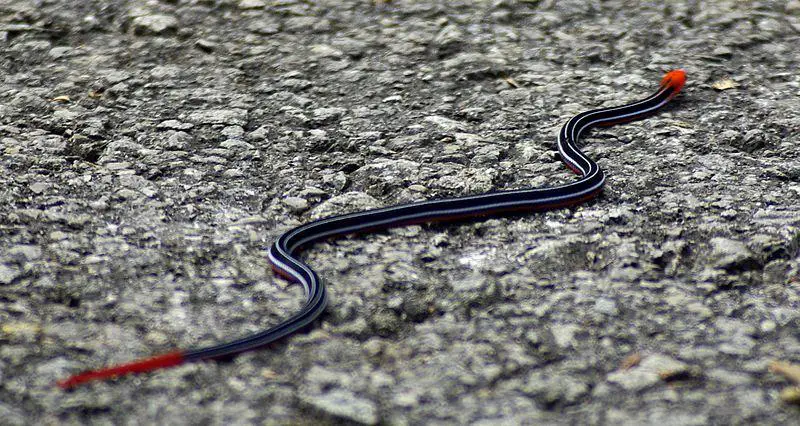Malaysia is among the most bio diverse countries in the world. It is rich in vertebrate fauna because of distinct mountain systems interspersed with rivers. It is because of these elements that it is home to some of the most remarkable species of snakes in the world. None more spectacular than the Blue Malayan Coral snake.
Snake classification
The snakes in Malaysia can be broadly classified into two families: Elapidae and Viperidae.
Elapidae family of snakes can be easily identified by their erect and short fangs on their Maxillary bone. Further the species in Malaysia have smooth scales and rounded pupils. Cobras, Coral snakes and Kraits belong to this family.
Viperidae family of snakes tend to have large distinct triangular heads and hollow fangs which are retractile. Their pupils are also elliptical. Vipers belong to this family.
When people think of “Coral snakes” they automatically associate them with the sea but the truth couldn’t be more far. Coral snakes are completely terrestrial and prefer living in a forest habitat which offers a lot of cover for hiding. The name Coral is assigned to these snakes because of its spectacular and eye-catching colors native to them.
Now let us look at this visually superlative snake. It is not only mesmerizing to look at but is also arguably one of the most interesting snakes in the wild.
The Blue Malayan Coral Snake:
Geographic Range and Distribution:
The Blue Malayan Coral is a primarily terrestrial snake. Its habitat is restricted to South East Asia. It prefers altitude of around 100-1100 m above sea level.
Based on current research there are currently three known subspecies. The first sub species Coral Blue Bivirgatus is found in Java-western Indonesia. The second sub species Coral Blue Flaviceps is found across Indonesia (Borneo, Sumatra, Lingga Archipelago, Bangka Island, Nias, Mentawai Archipelago, Cambodia, Riau Archipelago, West Malaysia (Malaya), Thailand and Singapore. Borneo has the third sub species, Coral Blue Tetrataenia.
Appearance:
The Blue Malayan Coral snake (Calliophis Bivirgata) is one of the largest species of Coral snakes. Full-grown adults may be under two meters in length. The head of the Blue Malayan Coral snake is bright red and the color extends throughout the belly of the snake and into its tail.
The exposed back of the body can be Black or Dark Blue or Indigo and sometimes has stripes of white streaked with Blue. This extraordinary color serves as a warning for predators. The nose is blunt which helps the snake in foraging leaves. These snakes are extremely venomous but very shy and not confrontational. They prefer to hide or slither away when confronted.
The snake, in its infancy is often mistaken for the pink-headed reed snake (Calamaria schlegeli) since they live in similar habitat. They also look quite similar. But the Pink-headed reed snake is much smaller reaching only to a maximum of 50 cm, when fully grown. In comparison, the Blue Malayan Coral Snake has been known to grown up to 140 cm. Also, the reed snake is not venomous while the Blue Malayan Coral snake is extremely venomous.
Habitat:
Spotting this snake in the open is extremely rare and is considered semi-fossorial. It is mostly found coiled in the leaf litter of forests.
Behaviour and Ecology:
It’s primary food source is snakes and sometimes even snakes from its own species. It also feeds on lizards, birds and frogs too. Since it is not by nature confrontational it tries to flee away when disturbed. Like a lot of coral snakes (genus Micrurus) it uses its appearance to drive away potential predators. This phenomenon is called an aposematic display. When under threat, they turn themselves over and expose their astonishingly bright ventral side. The bright colors on the ventral side acts as a warning to its foe. They also sometimes keep their tails erect like rattlers as a sign of aggression. But they don’t produce the signature rattling noise.
Reproduction:
As with 70% of all snakes, Blue Malayan Coral Snake is also Oviparous and lays up to 3 eggs. The Blue Malayan Coral Snake lays its eggs in secluded, dark places. Since the snakes are cold-blooded, they lay eggs in warm places. These places are away the hotspots of natural predators to ensure that the young ones hatch safely. The Blue Malayan Coral does not stay with the eggs after laying them. Instead, the young ones are left to fend for themselves once they hatch. This is the trait of almost all Oviparous snakes with the exception of some species of Boas and Pythons who are a lot more maternal. In such cases these snakes wrap around the eggs to provide them some warmth to incubate.
Venom:
The Blue Malayan Coral Snake venom is extremely poisonous and toxic. Like the other members of the Elapidae family the venom is predominantly neurotoxic. This means it directly impacts the nervous system.
What Makes the Blue Malayan Coral Snake interesting?
The venom in this snake is what stands out when compared with any other snake of any species. The Blue Malayan Coral has a very large venom gland to boot. These glands extend up to a quarter of their body length. This for a snake of its size is massive. When a prey is bitten, it may experience little to no symptoms for a few minutes. But, after a few minutes, the prey starts feeling numb around the wound. And in a few more minutes the prey is completely paralyzed.
There is a reason for the Blue Malayan Coral snake’s venom to be so rapid in its effectiveness. To understand this we need to look at the snake’s diet. This snake primarily eats other snakes, even other venomous snakes. So the venom has to act rapidly before the prey has a chance to bite the snake itself.
So, the venom of the Blue Coral has evolved into a very special kind. Its venom causes the prey to have continuous muscle spasms paralyzing the prey. This is not too dissimilar from a Cone shell or a scorpion venom. But what separates the Blue Malayan Coral is the quantity of venom and a new toxin by the name Calliotoxin.
Venom Profile:
With much difficulty, the University of Malaysia, has managed to collect the venom from this snake and have spent considerable resources analyzing the samples. By using a spectrometer scientists have been able to isolate some proteins in the venom.
The Blue Malayan Coral snake venom is however unique. It is predominantly made up of three-finger toxin and phospholipase A2, together making up approximately 60% of total proteins in the venom. There is, quite a lot of difference when it is compared to venom of many other snakes of the Elapidae family such as king cobra, kraits, cobras and sea snakes. The Blue Malayan Coral Snake’s venom does not contain post-synaptic alpha-neurotoxin. Instead, the unique maticotoxin and cytotoxin isoform, make up the second largest chunk of proteins in the venom, after phospholipase A2. This makes the Blue Malayan Coral the only snake in the Elapidae family with a dichotomous venom phenotype.
When this Coral snakes bites, its venom causes the neurons in our body to fire simultaneously. This leads to an instant spastic paralysis.
Apart from the above neurotoxin effects, the snake’s venom also has a toxin which is the unique Calliotoxin. It attacks the prey’s nervous system by modifying the sodium channels. The neurons in our body fire continuously and turn ON and OFF these sodium channels as and when we experience pain. What the snake’s venom does is, it keeps these Sodium channels open and does not allow it to close. The nervous system goes into overdrive and causes paralysis.
Fatalities:
While it is very rare of this snake to willfully attack humans, there have been reported deaths. This snake is popularly called as the “100 paces snake”. Because, after being bitten, it is highly unlikely the victim even moves 100 paces before collapsing.
There is also no known anti-venom for the Blue Malayan Coral Snake’s venom because scientists have not been able to replicate the calliotoxin in the venom.
Medical Applications:
Since research has shown that the venom affects the pain centers of the body, this has opened up several avenues of medical applications. The Sodium channels that this venom alters can now be applied to treat chronic pain in humans also. But research is still ongoing on this. The venom which is known to give the victim excruciating pain may ironically help in curing chronic pain if the research is successful.
Conservation Efforts:
With the erosion of the snake’s natural habitat due to development and encroachments their numbers have dwindled. According to some estimates nearly 80% of the snake’s habitat has now been eradicated by human development. Now, the conservationists have taken note of this and are trying to protect this exotic and spectacular snake. Hopefully with the efforts towards conserving this unique species we will be able to save this astonishing species from extinction.



